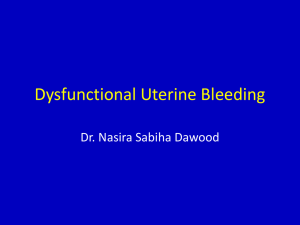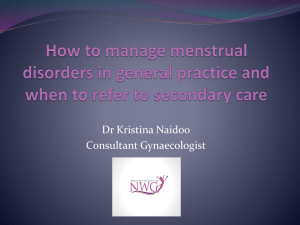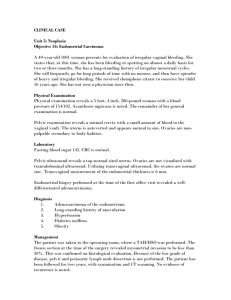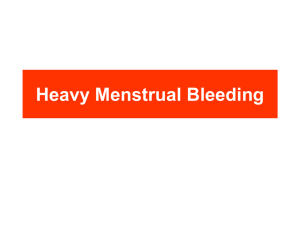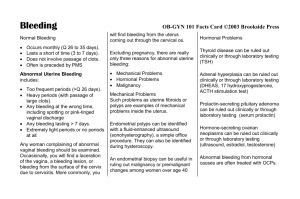vaginal bleeding
advertisement
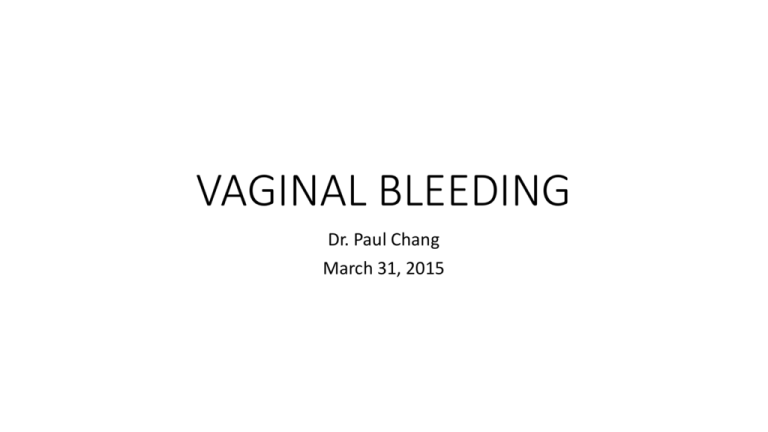
VAGINAL BLEEDING Dr. Paul Chang March 31, 2015 OUTLINE • Normal menstrual cycle • Definitions • Approach • Pre-Menopausal AUB • Post-Menopausal AUB • Early Pregnancy Related bleeding (First trimester) Differentials that I will not cover • Trauma • Bowel • Neonatal, Pediatric causes • Antepartum causes Abnormal Uterine Bleeding • In the absence of pregnancy… • Affects 11-13% of reproductive age women(up to 30% according to SOGC) • 24% in women aged 36-40 • Women generally present for care because the amount, timing, or other characteristics of the bleeding have changed from their individual norm Regulation of Menstrual Bleeding • In the endometrial lining, rising levels of estradiol produced by the follicles stimulate proliferative growth of epithelial and stromal elements. The endometrium thickens and becomes rich in progesterone receptors. • Once the LH surges, the ovum is released, and the follicle collapses to become the corpus luteum. The corpus luteum lasts for approximately 10 days and produces large amounts of progesterone. • Under the progestagenic influence, the endometrium enters the secretory phase. Endometrial growth stops, and the stroma becomes more compact and stable. Regulation of Menstrual Bleeding • If the egg is not fertilized, the corpus luteum degenerates and no longer produces progesterone, the estrogen level decreases, the top layers of the lining break down and are shed, and menstrual bleeding occurs Normal Dimensions of Menses • Frequency of menses • Every 24-38 days • Regularity of menses from cycle-to-cycle • +/- 2 to 20 days • Heaviness of flow • 5-80mL per month (avg 35mL) • Duration of flow • 4-8 days Definitions • Menorrhagia: menstrual periods with abnormally heavy or prolonged bleeding (>80mL per month) • Oligomenorrhea: cycle length > 35 days • Polymenorrhea: cyclic length > 24 days • Metrorrhagia: irregular intervals with normal or reduced volume and duration of flow • Menometrorrhagia: irregular intervals with excessive volume and duration of flow • Postmenopausal bleeding: bleeding that occurs more than 12 months after the last menstrual cycle FIGO Menstrual Disorders Working Group 2012 • Suggested new nomenclature for Abnormal Uterine Bleeding (AUB) • Goal: Simplify • Eliminate terminology such as menorrhagia, metrorrhaiga, and dysfunction uterine bleeding • Terminology for AUB • • • • • Volume Regularity Frequency Duration Other Menstrual History • Age of menarche • Volume • Regularity • Frequency • Duration • Associated symptoms: Pain, Mittelschmerz, premenstrual symptoms Bleeding History • Onset • Quantity • Pictorial blood assessment chart • Severity • How many pads? • Runs down legs? • Interfering with school, work? • Symptomatic • Black outs • SOB • Palpitations • Timing in relationship to menses • Other Locations: • Teeth • Bruising • Hemorrhage/transfusion hx • Associated symptoms: • vaginal discharge or odour • pelvic pain or pressure Approach History • Menstrual History • Bleeding History • OB History • Family History • Inherited coagulation disorders • PCOS • Endometrial or colon cancers • Meds including herbs • Anticoagulants • Antidepressants (SSRIs and tricyclics) • Hormonal contraceptives • Tamoxifen • Antipsychotics (first generation and risperidone) • Corticosteroids • Herbs: gensing, chasteberry, danshen Physical Exam • Vitals, weight, BMI • Signs of anemia • Conjunctivae Hb 95 • Hand Crease Hb 75 • Ocular Bruits Hb 55 • Signs of bleeding disorder • Petechiae, Ecchymoses, swollen joints • Thyroid exam • Gyn exam (bimanual and speculum) Investigations • CBC • bHCG • Ferritin • INR, PTT • TSH • Blood group and type • vWF screen when indicated (factor VIII, vWF antigen, vWF functional assay) • Pap smear and cervical cultures when indicated • Pelvic ultrasound/ saline infusion ultrasound • Endometrial biopsy • D&C • Hysteroscopy Saline Infusion Ultrasound • Sonohysterogram • Hysterosonogram Saline Infusion Ultrasound Acute Management • • • • • • • • • ABCs Vitals Estimate stage of shock IV, foley, pulse oximeter, O2 Bolus 1-2L of RL or NS Ultrasound Group and type & bHCG Call for help If pregnant, remember to assess the gestation (FHR), Rhogam if appropriate DDx By Age • 13-18 • • • • • Hypothalamic-Pituitary-Ovarian access immature Hormonal contraceptives Pregnancy Pelvic infection Coagulopathies DDx By Age • 19-39 • • • • • • Pregnancy Polyp Leiomyoma Anovulation (PCOS) Hormonal contraceptives Endometrial hyperplasia/cancer DDx By Age • 40 and over • • • • • • Anovulatory bleeding Endometrial Hyperplasia Endometrial Cancer Vaginal atrophy Use of anti-coagulants Rarely leiomyoma Medical Therapies • NSAIDs • Antifibrinolytics (Tranexamic Acid) • Combined Hormonal Contraceptives • Cyclical progestins for anovulatory bleeding • Continous high dose progestins • Depo medroxyprogesterone acetate • Levonorgestrel IUD • GnRHa High Yield Diagnosis & Its Management Endometrial Polyps • Overgrowth of cells in the lining of the uterus (endometrium) leads to the formation of uterine polyps, also known as endometrial polyps • Menstrual characteristic: • Intermenstrual spotting • Hysteroscopic resection Adenomyosis • Endometrial tissue, which normally lines the uterus, exists within and grows into the muscular wall of the uterus • Often asymptomatic • Menstrual characteristic: • Heavy, prolonged periods • • • • Dysmenorrhea Dyspareunia Inter-menstrual bleeding O/E: Enlarged uterus • Hormonal contraceptives • NSAIDs • Dienogest (Visanne©) • Mirena© • GnRHa • Hysterectomy Adenomyosis Fibroids • Monoclonal non-cancerous growth of the myometrium • As many as 3 out of 4 women have uterine fibroids sometime during their lives • Often asymptomatic • Menstrual characteristic: • Heavy prolonged periods • U/S: bulky uterus • Hormonal contraceptives (*personally do not recommend) • NSAIDs • Tranexamic acid • SPRMs (Fibristil©) • Mirena© • GnRHa • Myomectomy • Uterine artery embolization • mrHIFU • Hysterectomy Fibroids Fibristil© • Ulipristal acetate • Selective Progesterone Receptor Modulator Von Willebrand Disease • Most cases are autosomal dominant inherited disorders. Most severe form is autosomal recessive. May be acquired • Most common inherited bleeding disorder • The prevalence of vWD is about 1 in 100 individuals. However the majority of these people do not have symptoms. The prevalence of clinically significant cases is 1 per 10,000 • Menstrual characteristic: • Heavy volume is more prevalent (57-93% vs. 10% in normal controls) • Special tests: vWF screen (factor VIII, vWF antigen, cWF functional assay) • Medical Management: • • • • • • • OCP Depo-Provera Mirena GnRHa Tranexamic Acid DDAVP* Replacement therapy (Humate-P, platelets, cryoppte, FFP) • Surgical Management: Endometrial Ablation • Contraindications: NSAIDs Anovulatory • Most common: PCOS • Hypothalamic hypogonadism • Premature ovarian failure • Menstrual characteristic: • Irregular with variable frequency and duration • Hormonal contraceptives • Cyclical progestins Iatrogenic: Breakthrough Bleeding • Non-menstrual bleeding while on hormonal contraceptives • The low dose of oestrogen in modern contraceptive pills is insufficient to maintain endometrial integrity and the opposing effect of progestogen promotes atrophy of glands and stroma. The resulting endometrium is thin, fragile and prone to bleeding • Menstrual characteristic: • Light and intermenstrual • Reassurance: continue CHC for up to 3 months • Change to a more estrogenic CHC • Consider vaginal ring • Refer to Dr. Nayot’s talk Endometrial • AUB can occur in women with normal ovulatory function, and without coagulopathies because of abnormalities that reside in the endometrium: • Abnormal prostaglandin synthesis • Prostaglandin receptor upregulation • Increased fibrinolytic activity • Increased tissue plasminogen activity • NSAIDs • Hormonal contraceptives • Progestins • Mirena© • Tranexamic acid • SPRMs (Fibristil©) • GnRHa • Endometrial ablation • Hysterectomy Early Pregnancy • Remember to give Rhogam if mom is Rh-ve (unless certain that of paternity and that he is also Rh-ve) • <12 wk GA, 120mcg IM • 12 wks and higher, 300mcg IM • DO NOT FORGET: Follow bHCG to zero if non-viable Abortion • Expectant • Misoprostol • D&C Ectopic • Send to hospital • MTX • Laparoscopic surgery Molar Pregnancy • Suction D&C • Oxytocin during curettage • MTX Endometrial Hyperplasia • Risk factors: • • • • • • • Nulliparity Late menopause Obesity Smoking Anovulation (PCOS) Unopposed estrogen Tamoxifen • Endometrial biopsy or D&C • Pelvic ultrasound (≤4mm is low risk) • Hysteroscopy Endometrial Hyperplasia WHO Progression to Cancer Simple Hyperplasia 1% Complex Hyperplasia 3% Atypical Simplex Hyperplasia 8% Atypical Complex Hyperplasia 29% • Medical Management • Progesterone therapy • Provera 10mg 14 days per month (x 3 months) • Megace • Mirena • Clomid (SERM) • Surgical Management: Hysterectomy Endometrial cancer • Most common gynecologic cancer in North America • Avg age for endometrial ca is 61 • 5-30% of cases occur in premenopause • HPNCC have a lifetime risk for endometrial ca of 40-60% • Refer to Gynecologic Oncologist Summary • Rule out pregnancy • PALM COEIN (I = iatrogenic and infectious) • History (menstrual, bleeding) • Physical • Investigations • Acute management • On-going therapies • Refer if appropriate • Read the question. Breathe. You can do it! Thank You

